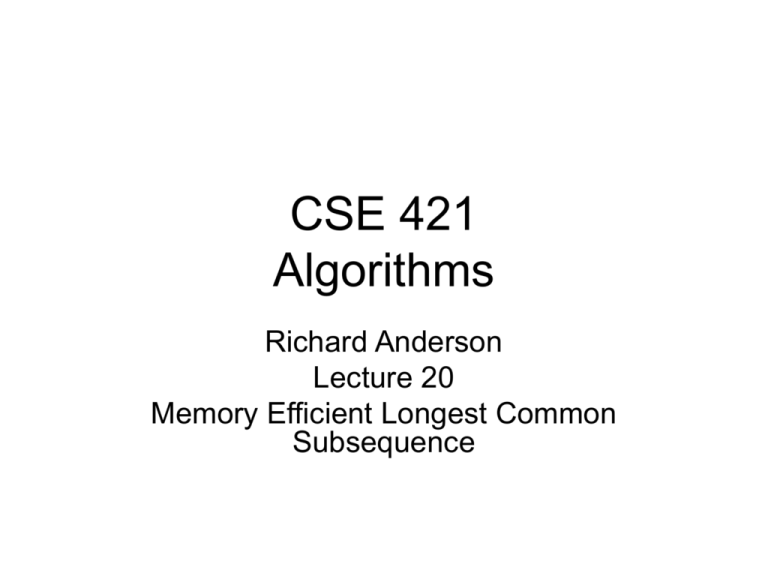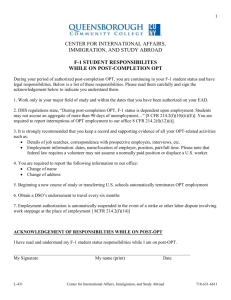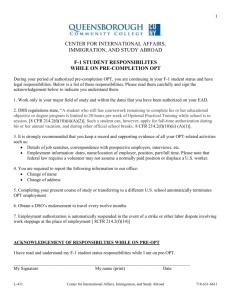PPT
advertisement

CSE 421
Algorithms
Richard Anderson
Lecture 20
Memory Efficient Longest Common
Subsequence
Longest Common Subsequence
• C=c1…cg is a subsequence of A=a1…am if
C can be obtained by removing elements
from A (but retaining order)
• LCS(A, B): A maximum length sequence
that is a subsequence of both A and B
ocurranec
attacggct
occurrence
tacgacca
LCS Optimization
• A = a1a2…am
• B = b1b2…bn
• Opt[ j, k] is the length of
LCS(a1a2…aj, b1b2…bk)
Optimization recurrence
If aj = bk, Opt[ j,k ] = 1 + Opt[ j-1, k-1 ]
If aj != bk, Opt[ j,k] = max(Opt[ j-1,k], Opt[ j,k-1])
Dynamic Programming
Computation
A[1..m], B[1..n]
for i := 1 to m
Opt[i, 0] := 0;
for j := 1 to n
Opt[0,j] := 0;
b1…bn
Storing the path information
Opt[0,0] := 0;
a1…am
for i := 1 to m
for j := 1 to n
if A[i] = B[j] { Opt[i,j] := 1 + Opt[i-1,j-1]; Best[i,j] := Diag; }
else if Opt[i-1, j] >= Opt[i, j-1]
{ Opt[i, j] := Opt[i-1, j], Best[i,j] := Left; }
else
{ Opt[i, j] := Opt[i, j-1], Best[i,j] := Down; }
Algorithm Performance
• O(nm) time and O(nm) space
• On current desktop machines
– n, m < 10,000 is easy
– n, m > 1,000,000 is prohibitive
• Space is more likely to be the bounding
resource than time
Observations about the Algorithm
• The computation can be done in O(m+n)
space if we only need one column of the
Opt values or Best Values
• The algorithm can be run from either end
of the strings
Computing LCS in O(nm) time and
O(n+m) space
• Divide and conquer algorithm
• Recomputing values used to save space
Divide and Conquer Algorithm
• Where does the best path cross the
middle column?
• For a fixed i, and for each j, compute the
LCS that has ai matched with bj
Constrained LCS
• LCSi,j(A,B): The LCS such that
– a1,…,ai paired with elements of b1,…,bj
– ai+1,…am paired with elements of bj+1,…,bn
• LCS4,3(abbacbb, cbbaa)
A = RRSSRTTRTS
B=RTSRRSTST
Compute LCS5,0(A,B), LCS5,1(A,B),…,LCS5,9(A,B)
A = RRSSRTTRTS
B=RTSRRSTST
Compute LCS5,0(A,B), LCS5,1(A,B),…,LCS5,9(A,B)
j
left
right
0
0
4
1
1
4
2
1
3
3
2
3
4
3
3
5
3
2
6
3
2
7
3
1
8
4
1
9
4
0
Computing the middle column
• From the left, compute LCS(a1…am/2,b1…bj)
• From the right, compute LCS(am/2+1…am,bj+1…bn)
• Add values for corresponding j’s
• Note – this is space efficient
Divide and Conquer
• A = a1,…,am
• Find j such that
B = b1,…,bn
– LCS(a1…am/2, b1…bj) and
– LCS(am/2+1…am,bj+1…bn) yield optimal solution
• Recurse
Algorithm Analysis
• T(m,n) = T(m/2, j) + T(m/2, n-j) + cnm
Prove by induction that
T(m,n) <= 2cmn
Memory Efficient LCS Summary
• We can afford O(nm) time, but we can’t
afford O(nm) space
• If we only want to compute the length of
the LCS, we can easily reduce space to
O(n+m)
• Avoid storing the value by recomputing
values
– Divide and conquer used to reduce problem
sizes





